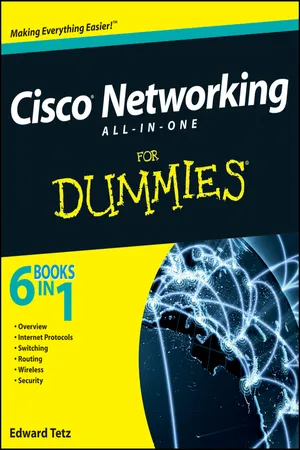
- English
- ePUB (mobile friendly)
- Available on iOS & Android
Cisco Networking All-in-One For Dummies
About this book
A helpful guide on all things Cisco
Do you wish that the complex topics of routers, switches, and networking could be presented in a simple, understandable presentation? With Cisco Networking All-in-One For Dummies, they are! This expansive reference is packed with all the information you need to learn to use Cisco routers and switches to develop and manage secure Cisco networks. This straightforward-by-fun guide offers expansive coverage of Cisco and breaks down intricate subjects such as networking, virtualization, and database technologies into easily digestible pieces.
- Drills down complex subjects concerning Cisco networking into easy-to-understand, straightforward coverage
- Shares best practices for utilizing Cisco switches and routers to implement, secure, and optimize Cisco networks
- Reviews Cisco networking solutions and products, securing Cisco networks, and optimizing Cisco networks
- Details how to design and implement Cisco networks
Whether you're new to Cisco networking products and services or an experienced professional looking to refresh your knowledge about Cisco, this For Dummies guide provides you with the coverage, solutions, and best practices you need.
Frequently asked questions
- Essential is ideal for learners and professionals who enjoy exploring a wide range of subjects. Access the Essential Library with 800,000+ trusted titles and best-sellers across business, personal growth, and the humanities. Includes unlimited reading time and Standard Read Aloud voice.
- Complete: Perfect for advanced learners and researchers needing full, unrestricted access. Unlock 1.4M+ books across hundreds of subjects, including academic and specialized titles. The Complete Plan also includes advanced features like Premium Read Aloud and Research Assistant.
Please note we cannot support devices running on iOS 13 and Android 7 or earlier. Learn more about using the app.
Information



Table of contents
- Cover
- Table of Contents
- Title Page
- Introduction
- Book I: Overview
- Book II: Internet Protocols
- Book III: Switching
- Book IV: Routing
- Book V: Wireless
- Book VI: Security
- Cheat Sheet